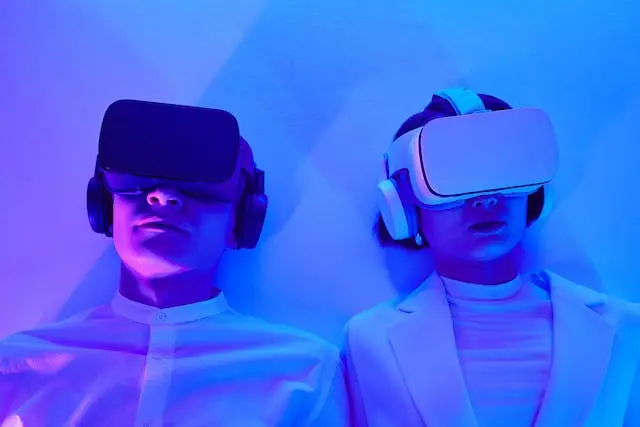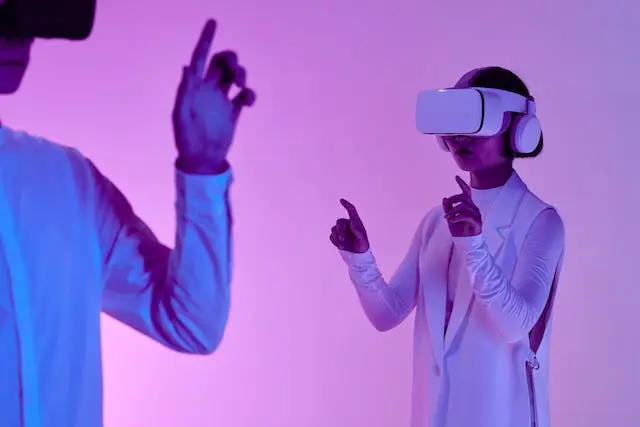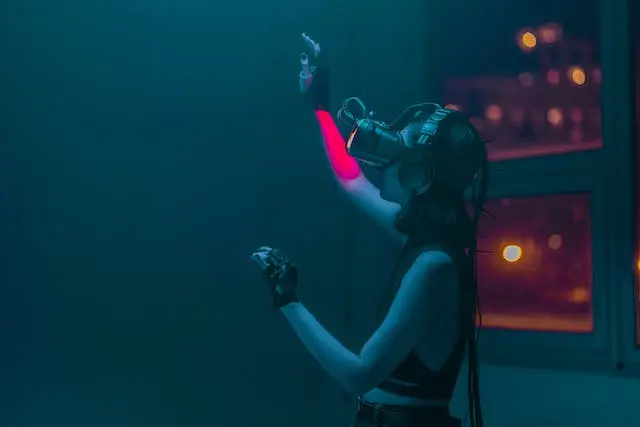In the ever-evolving landscape of technology, augmented reality (AR) has emerged as a groundbreaking innovation that blurs the lines between the digital and physical worlds. Augmented reality holds immense potential, revolutionizing various industries and shaping the way we interact with our surroundings. In this comprehensive article, we delve into the depths of augmented reality, exploring its meaning, technology, platforms, examples, and its intersection with virtual reality. Join us on a journey to uncover the exciting realm of augmented reality.
Cracking the Code of Augmented Reality: From Invisible Layers to Superpower Senses
Imagine dragons soaring through your living room, historical figures strolling down the street, or instructional overlays guiding you through complex repairs – that’s the magic of augmented reality (AR). But before we get lost in daydreams of dancing dinosaurs, let’s break down what AR really is:

AR is like a digital paintbrush, delicately brushing onto the canvas of the real world. Unlike its flashier cousin, virtual reality (VR), which plunges you into a fully fabricated realm, AR seamlessly blends the physical and digital, like an invisible ink that reveals hidden layers of information and interaction.
Think of it as a superpower for your senses. Hold your phone over a museum exhibit, and suddenly, dinosaurs roar to life, ancient battles unfold, and cryptic hieroglyphs whisper their secrets. Looking for that elusive screw while assembling furniture? AR overlays a step-by-step guide, transforming your frustration into a breeze.
Here are some examples that paint a vivid picture of AR’s potential:
- Shop like a pro: Imagine trying on clothes without stepping foot in a store. AR mirrors let you virtually drape garments over your body, adjusting styles and colors in real-time. No more awkward fitting rooms – just confident clicks and conquered closets!
- Unleash the inner explorer: Get lost in ancient ruins without leaving your couch. AR overlays historical reconstructions on top of present-day landmarks, transporting you back in time and whispering tales of forgotten civilizations.
- Become a DIY whiz: Need to fix a leaky faucet? AR tutorials project step-by-step instructions directly onto your plumbing, guiding your wrench like a digital Yoda. No more deciphering cryptic manuals – just follow the glowing path to plumbing prowess!
- Level up your learning: Imagine dissecting a frog without the squeam factor. AR overlays interactive 3D models on textbooks, bringing anatomy lessons to life and turning classrooms into immersive science labs.
And that’s just the tip of the iceberg! From revolutionizing education and healthcare to enhancing gaming and entertainment, AR’s possibilities are as endless as our imaginations.
So, the next time you hold your phone, remember – it’s not just a window to the digital world, but a portal to augmenting the one right around you. With AR, the boundaries between real and virtual blur, unleashing a playground of possibilities where dragons dance in living rooms and history whispers from every street corner.
Decoding the AR Toolbox: From Bits and Circuits to Bionic Vision
Augmented reality isn’t just a cool party trick – it’s a meticulously crafted symphony of technology. To truly appreciate its magic, we need to peek under the hood and understand the instruments that make AR sing.

Imagine AR as a high-tech orchestra, each component playing a critical role in the immersive performance. First, there’s the conductor: software algorithms that process data, track your movements, and orchestrate the digital overlays in real-time. Like a master conductor, these algorithms ensure the virtual notes blend seamlessly with the physical world.
Then come the musicians: a medley of hardware components that bring the digital notes to life. Cameras capture the surrounding environment, sensors track your head and gaze, and tiny projectors beam digital light onto your field of view. These are the virtuosos that paint the invisible layers onto reality.
And here’s where nReal steps in, like a rockstar soloist. Imagine AR glasses so light and stylish they feel like a natural extension of yourself. That’s what nReal brings to the table. Their sleek glasses are the future of AR hardware, making the technology accessible and everyday, without sacrificing visual fidelity or coolness.
With nReal, information dances across your vision, blurring the lines between the physical and digital. Need directions? A glowing arrow subtly guides you. Craving historical context? Buildings whisper their stories through interactive overlays. Want to learn? 3D models explode from textbooks, turning your world into a classroom without walls.
Forget clunky headsets and bulky goggles. nReal’s AR glasses are the invisible orchestra pit, seamlessly integrating the digital symphony into your life. They’re the bridge between today’s screens and tomorrow’s bionic vision, where information flows effortlessly around us, enriching every moment.
Building Bridges to Blended Reality: The Rise of AR Platforms
Augmented reality isn’t just a futuristic fantasy anymore – it’s rapidly becoming a part of our everyday lives. And bridging the gap between potential and reality are AR platforms, the tools that empower developers to build the apps and experiences that will revolutionize the way we interact with the world around us.
One shining star in this constellation of platforms is Google AR. Imagine a toolbox brimming with cutting-edge software development kits (SDKs), powerful libraries, and intuitive frameworks – that’s what Google AR offers. It’s like handing developers a paintbrush dipped in digital magic, allowing them to create stunning AR experiences for millions of Android users.
With Google AR, businesses can:
- Transform their products: Imagine furniture companies letting customers virtually place sofas in their living rooms before buying, or car dealerships offering test drives through augmented cityscapes. Google AR makes it possible, blurring the lines between the physical and digital to create immersive product experiences.
- Boost customer engagement: Think interactive museum exhibits where dinosaurs come to life, or shopping malls where virtual try-on rooms let you experiment with endless styles. Google AR empowers businesses to engage customers in innovative ways, turning every interaction into a captivating adventure.
- Revolutionize the service industry: Imagine mechanics using AR overlays to diagnose engine problems, or surgeons visualizing complex procedures with holographic models. Google AR brings efficiency and precision to countless industries, changing the way we work and live.
But Google AR is just one piece of the puzzle. Platforms like Apple’s ARKit and Facebook’s Spark AR Studio are also playing vital roles in democratizing AR development and bringing the technology to the masses. As these platforms continue to evolve, we can expect a surge in creative AR applications across various sectors, from education and healthcare to gaming and entertainment.
Exploring Augmented Reality Examples
The practical applications of augmented reality are vast and varied. From gaming to healthcare, education to retail, AR is making waves across industries. Let’s delve into some compelling augmented reality examples that showcase the versatility and transformative power of this technology.
Healing with Holograms: Augmented Reality Reshapes Healthcare
Imagine peering into a patient’s chest, not with a scalpel, but with a digital scalpel – one that overlays vital organs and arteries, guiding your every move with pinpoint precision. That’s the future of surgery unfolding right before our eyes, thanks to the revolutionary power of augmented reality (AR) in healthcare.
No longer a sci-fi trope, AR is already transforming operating rooms into high-tech havens. Surgeons don AR glasses or headsets, witnessing a kaleidoscope of digital information superimposed on the patient’s anatomy. X-rays and CT scans dance over organs, blood vessels glow like neon rivers, and tumor margins materialize like ghostly outlines. This real-time, augmented intelligence empowers surgeons to navigate complex procedures with unprecedented accuracy, minimizing risks and maximizing success.
But the magic of AR in healthcare extends beyond the operating room. Medical students don simulated AR headsets, stepping into virtual anatomy labs where they practice delicate dissections and intricate suture techniques, honing their skills without touching a living soul. Imagine mastering neurosurgery on a holographic brain or perfecting laparoscopic techniques on a 3D-printed abdomen – AR makes it possible, offering a risk-free environment for future medical heroes to learn and grow.
The benefits of AR ripple outwards, touching every facet of the healthcare landscape. Nurses rely on AR-powered vein finders to locate veins with laser-like precision, eliminating painful needle hunts and boosting patient comfort. Therapists guide patients through rehabilitation exercises with animated overlays, transforming tedious routines into interactive game sessions. Even patients themselves can benefit from AR, visualizing their treatment plans, accessing real-time health data, and connecting with doctors remotely through immersive telehealth consultations.
Shopping Made Magical: How AR is Reimagining Retail
Forget the fluorescent lights and endless aisles – the future of retail is bathed in digital pixie dust, courtesy of augmented reality (AR). No longer just a futuristic gimmick, AR is transforming the way we shop, injecting a dose of magic and convenience into every click and cartwheel.
Imagine swirling clothes around your virtual avatar, trying on outfits before stepping foot in a store. No more mountains of discarded garments in fitting rooms. Just a tap on your phone and bam! You’re rocking a royal ball gown on your balcony or strutting in a swimsuit on a virtual beach. AR mirrors make indecisiveness a relic of the past, letting you find your perfect look with confidence and pizzazz.
But the magic doesn’t stop at wardrobes. Furniture shopping, once fraught with tape measures and furniture Tetris nightmares, transforms into a delightful game of “what if?”. Picture yourself placing a life-size virtual sofa in your living room, adjusting its color and fabric from the comfort of your couch. See how that sleek Scandinavian table harmonizes with your existing decor before it even leaves the warehouse. AR takes the guesswork out of home furnishing, ensuring your next purchase isn’t a decorating disaster.
And it’s not just about aesthetics. AR-powered product labels whisper tales of provenance and sustainability, revealing the journey of that coffee mug from bean to brew or the ethical manufacturing process behind your new shoes. Transparency becomes a dazzling spectacle, empowering consumers to make informed choices while brands build trust and loyalty.
But here’s the real spellbinding part: AR isn’t just about fancy filters and virtual showrooms. It’s about creating a seamless, personalized shopping experience. Imagine walking into a store, your phone guiding you to hidden deals and product recommendations based on your past purchases and browsing habits. Picture interactive displays that come alive as you approach, offering product demos and personalized tutorials. AR bridges the gap between the online and offline worlds, making every shopping trip feel like a treasure hunt tailored just for you.
Virtual Reality and Augmented Reality: Bridging Realities
While often discussed separately, virtual reality (VR) and augmented reality (AR) share common ground in their pursuit of altering our perception of reality. While AR enhances the real world with digital elements, VR immerses users in a completely virtual environment. The synergy between these technologies opens up possibilities for mixed reality experiences, where the boundaries between the physical and virtual worlds blur even further.
Elon Musk on Augmented Reality: Potential, Concerns, and the Road Ahead
Elon Musk, the ever-enigmatic tech mogul, has a nuanced and occasionally contradictory take on augmented reality (AR). Here’s a peek into his kaleidoscope of thoughts:

The Upside:
Potential: Musk acknowledges the immense potential of AR, particularly in enhancing productivity and learning. He’s impressed by the ability to overlay information onto the real world, envisioning applications like mechanics using AR overlays to diagnose engine problems or surgeons visualizing complex procedures with holographic models.
Accessibility: Unlike its bulky VR cousin, Musk appreciates AR’s potential for wider adoption due to its less intrusive nature. He envisions lightweight, stylish glasses like nReal’s as the future of AR, seamlessly integrating digital information into our daily lives.
The Reservations:
Distraction: Musk worries about AR becoming a constant distraction, pulling us away from the real world and potentially impacting social interaction. He emphasizes the importance of responsible development and mindful usage, ensuring AR enhances our lives, not consumes them.
Metaverse Skepticism: While acknowledging AR’s potential, Musk isn’t a champion of the “metaverse” hype. He criticizes the idea of spending excessive time in virtual worlds, questioning its long-term societal impact.
The Verdict:
Musk’s opinion on AR is a swirling vortex of excitement and caution. He’s undoubtedly impressed by its potential to revolutionize various fields, but his concerns about distraction and the metaverse highlight the need for responsible development and mindful integration.
To sum it up:
- Musk sees AR as a powerful tool, not a replacement for reality.
- He emphasizes the importance of accessibility and responsible use.
- He’s wary of the metaverse hype and its potential downsides.
Frequently Asked Questions (FAQs)
Q1: What is the difference between augmented reality and virtual reality?
A: Augmented reality enhances the real world by overlaying digital information, while virtual reality immerses users in a completely virtual environment.
Q2: How does nReal contribute to augmented reality technology?
A: nReal is a prominent player in the AR hardware space, creating lightweight and stylish AR glasses that bring augmented reality experiences to a broader audience.
Q3: Can augmented reality be used in healthcare?
A: Absolutely. Augmented reality in healthcare improves surgical precision, aids in medical training, and enhances overall patient care.
Q4: How is AR transforming the retail industry?
A: AR in retail allows customers to virtually try on products, visualize furniture in their homes, and offers a personalized and interactive shopping experience.
Conclusion: Navigating the Augmented Horizon
In conclusion, augmented reality is not just a technological advancement but a transformative force reshaping how we perceive and interact with the world. From the sleek AR glasses by nReal to the expansive capabilities of Google AR, the landscape is evolving at an unprecedented pace. As we navigate the augmented horizon, the fusion of digital and physical realities promises an exciting future—one where the boundaries between the two become increasingly indistinguishable. Embrace the augmented reality revolution, for it is not merely a glimpse into the future but a step into a new dimension of human experience.
